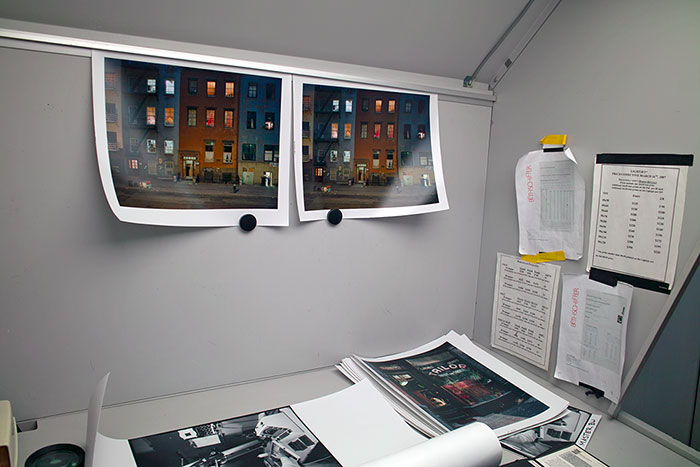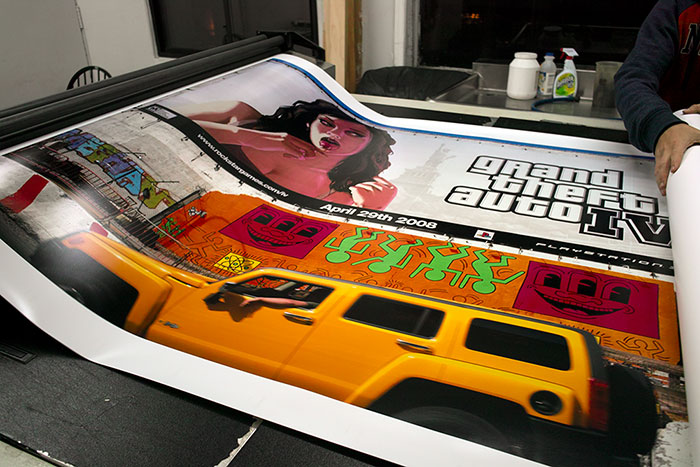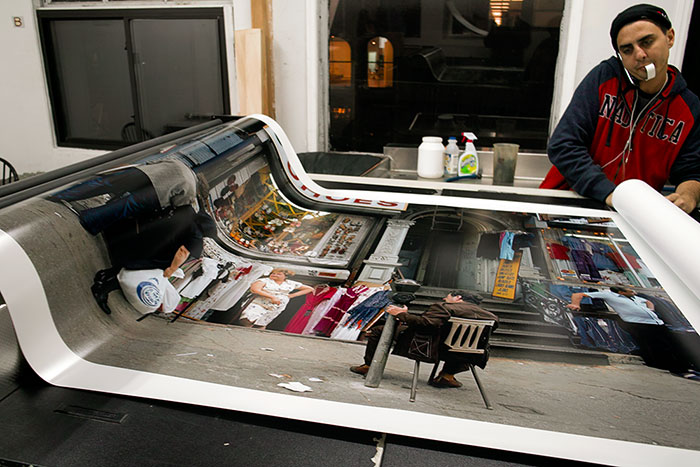Comparing two tests before making a 50×62 inch print — © Brian Rose
I have completed printing for my upcoming show at Dillon Gallery in New York City. The opening is March 7, and I’ll be posting a formal invitation soon. Yesterday I spent about eight hours in the lab shepherding my digital files through the process of printing them on paper. Although many photographers now use inkjet printers, I still find the look and feel of c-prints preferable for my work. The beauty of older analog color prints was the naturalistic color and slight softness in rendering light and detail. So much of what you see these days in galleries and museums is over saturated, over contrasty, and over sharpened–brittle. Photoshop is the most wondrous of programs, but it is also a Pandora’s box, and no matter what kind of print you make, digital c or inkjet, the temptation is always there to do too much.
Most of my project work–fine art photography–I continue to use 4×5 film. There may come a day when I switch over to digital, but we’re not quite there yet. In this case, with the Lower East Side work, it is especially nice to place images next to each other taken 30 years apart all made on essentially the same material. The big difference now is that I scan everything, both old and new, and do all the color correcting in Photoshop. Analog projection printing was generally limited to making global corrections, like adding or subtracting yellow from the mix. One worked step by step gradually finding a color balance that felt natural, had a sense of depth, that felt clean, unmasked. Many negatives, however, presented challenges and I was never wholly satisfied with the results. Photoshop provides tremendous control of every aspect of the image, and I’m not talking about the kind of manipulation that everyone is familiar with. I’m talking about the ability to make subtle, carefully modulated changes that enhance the overall quality of the image. Once you’ve become proficient in Photoshop, there’s little nostalgia for the old analog method.
One of the recent images from Times and Space on the Lower East Side coming off the machine — © Brian Rose
In the case of the images I did with Ed Fausty in 1980, it isn’t possible to make decent analog prints, even if I wanted to. The different layers in the film emulsion have faded or shifted, and the color balance has been has been permanently thrown off. I tried making analog prints from the old negatives some years ago, but gave up after a few hours of futility. Digital has essentially saved these images. It can be a lot of work–hours, even days–coaxing the color out of the old negatives. The results, however, are often amazing–prints that are far better than the original prints.
Nowadays you are not really making the image in the darkroom as before. Most of the work is done in Photoshop, and lab is the final step. Typically, I bring my digital files on a flash drive, copy them onto the server at the lab, look at the images on their setup to see if looks much different than my studio computer. Usually, the difference is minimal, and one or two sets of small test prints are all that is needed before going to the full size prints. In this case, I am making 50×62 and 20×25 inch prints.
Orchard Street in 1980 coming off the machine at Beth Schiffer Labs in lower Manhattan — © Brian Rose
There will be 25 prints in the show at Dillon, about half of them in the size seen above. Not having printed this large before, it was pretty awesome seeing the images roll off of machine. There is a tendency these days to print too large–mostly for market reasons rather than aesthetic–but these images were made in 4×5 for the monumentality that the format brought to the subject. It was one of my goals when undertaking the Lower East Side Project, to describe, amplify, and preserve for all time the streets and architecture of the place. Printing this size achieves that original goal. Ed and I made several large prints–30×40 inches–in 1981 when we exhibited the work at the Henry Street Settlement. It was incredibly impressive then to see color prints of that size. It’s more routine now. But I think these images will impress nevertheless.


